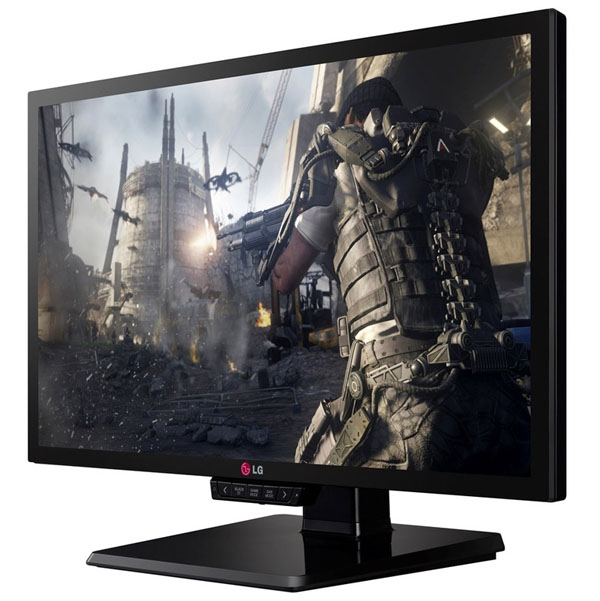Early Verdict
If you can live without frame-rate matching, the LG 24GM77 is a great value in 144Hz gaming monitors. With some of the best stock performance we’ve seen in any category, you don’t have to adjust anything save brightness to see a superb image in all contexts. With its well-engineered gaming features, excellent performance and relatively low price, this is an easy recommendation.
Pros
- +
Out-of-box accuracy, even better calibrated accuracy
- +
high contrast
- +
bright and sharp image
- +
excellent motion-blur reduction
- +
low input lag
- +
solid build quality
- +
side-mounted headphone jack
Cons
- -
TN panel
- -
no G-Sync or Active Sync
- -
game modes introduce unwanted edge enhancement
Why you can trust Tom's Hardware
Introduction
With many gamers waiting for AMD's FreeSync initiative to bear fruit or cheaper G-Sync-capable monitors to show up, it’s easy to forget that the prices for high-speed screens without those features are dropping to saner levels. A year ago, 144Hz displays in the 24-inch form factor were selling around $400. That was quite a premium when 60Hz panels went for $200 or less.

Today we’re looking at one such display – LG’s 24GM77. It won't sync to the output of your graphics card, but it does have many other features that will be of interest to gamers. In addition to a maximum refresh of 144Hz, you get an excellent blur-reduction option called Motion 240. There’s also a Black Stabilizer gamma control to aid in shadow detail rendering. If you like to change your picture to suit particular titles, there are six gaming modes that do just that. Finally, there’s a Dynamic Action Sync (DAS) option purported to cut input lag in half.
| Brand & Model | LG 24GM77 |
|---|---|
| Panel Type & Backlight | TN / W-LED, edge array |
| Screen Size & Aspect Ratio | 24in / 16:9 |
| Max Resolution & Refresh | 1920x1080 @ 144Hz |
| Native Color Depth & Gamut | 8-bit / sRGB |
| Response Time (GTG) | 1ms |
| Brightness | 350cd/m2 |
| Speakers | - |
| Video Inputs | 1 x DisplayPort, 1 x DVI, 2 x HDMI, 1 x VGA |
| Audio | 1 x 3.5mm headphone output |
| USB | v3.0 - 1 x up, 2 x down |
| Panel DimensionsWxHxD w/base | 22.5 x 15.9 x 9.8in567 x 401 x 248mm |
| Panel Thickness | 2.2in / 57mm |
| Bezel Width | .6in / 16mm |
| Weight | 11.9lbs / 5.8kg |
| Warranty | Three years |
Like almost every other high-speed screen out there, the 24GM77 employs a TN-based panel. Naturally, this one uses a part manufactured by LG. It offers high brightness, an 8-bit color depth and again, refresh rates as high as 144Hz. The only capabilities gamers will miss are Nvidia's G-Sync and AMD's FreeSync technologies. We’ve already seen several monitors with G-Sync, and are starting to receive FreeSync-capable displays.
The white LED backlight dispenses with PWM (pulse-width modulation), which can cause flicker for some users, and exposes an excellent blur-reduction feature called Motion 240. We’re usually guarded in our opinions of backlight strobing because it can significantly reduce light output. Here, LG chooses to omit any sort of pulse-width adjustment, but it isn't missed. Our contrast tests show a mere 15-percent reduction in peak white level when Motion 240 is turned on.
Of course, the main reason to buy a monitor like this one is speed. Running at 120 or 144Hz means there is very little motion blur, even without backlight strobing. Also, you're able to enjoy the full performance of your high-end graphics hardware with v-sync turned on. Variable refresh technologies are great, but at the very least you need a monitor that won't limit your frame rates.
The 24GM77’s most attractive feature, in our opinion, is its price tag. Selling for around $300, it represents a good deal when G-Sync adds at least $100 to the cost of a 24-inch monitor. All we need to see now is good color accuracy, and that’s where our benchmark tests do the talking.
Correction: This article was updated at 2:15 pm ET to include the proper proper size of the monitor — 24-inches, not 27.

Christian Eberle is a Contributing Editor for Tom's Hardware US. He's a veteran reviewer of A/V equipment, specializing in monitors. Christian began his obsession with tech when he built his first PC in 1991, a 286 running DOS 3.0 at a blazing 12MHz. In 2006, he undertook training from the Imaging Science Foundation in video calibration and testing and thus started a passion for precise imaging that persists to this day. He is also a professional musician with a degree from the New England Conservatory as a classical bassoonist which he used to good effect as a performer with the West Point Army Band from 1987 to 2013. He enjoys watching movies and listening to high-end audio in his custom-built home theater and can be seen riding trails near his home on a race-ready ICE VTX recumbent trike. Christian enjoys the endless summer in Florida where he lives with his wife and Chihuahua and plays with orchestras around the state.
-
Mike Coberly Reply24" TN, 1080p? No variable refresh? No thanks.
so is it a 24" or 27" display?
LG's website indicates that it is indeed a 24" panel, the title is incorrect in stating it is a 27" -
NinjaNerd56 I got an AOC 27 inch display under $300 recently. No SYNC ability, but a really nice device that's excellent with the games I play.Reply
It's GAME mode is good, and I have done zero adjustment beyond that. If it lasts 2-3 years, then I can 'upgrade' at a much cheaper price to whatever sync de jour display I want.
-
JeanLuc For a gaming monitor to be released these days that does not to come with Gsync or Freesync capability is very short sighted by LG. Would the inclusion of a Freesync enabled 1.2a displayport really have delayed or added considerable costs to this monitor, LG?Reply -
Marcus52 This article - seriously? You can't even get the size of the monitor right. And the price isn't anything special for a 24" 144 Hz TN panel, Asus has had one in that price range (under $300) for years now. In my mind these things make the entire article suspect.Reply